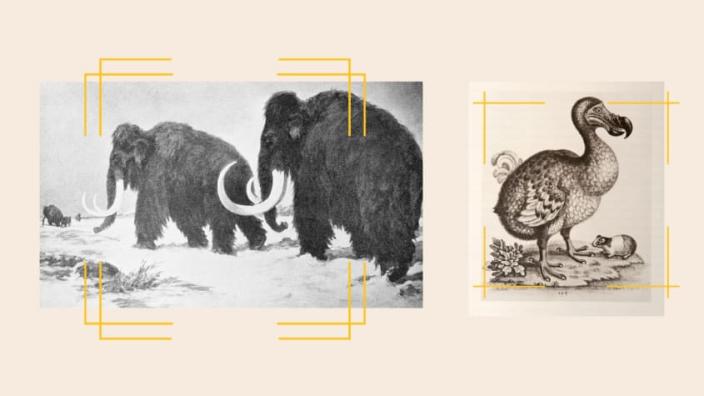
Scientists at a Dallas, Texas-based company recently announced that they would be attempting to bring the dodo bird, which became extinct in 1681, back to life with a process called de-extinction. Why do researchers want to revive species that are long gone?
What is de-extinction, and how does it work?
De-extinction, also known as “resurrection biology” and “reanimation,” reverses extinction in plants and animals using the genetics of closely related living species, explains Colossal Biosciences, the company behind the efforts to revive the dodo bird. Cloning is the most well-known de-extinction method, although back-breeding and genome editing also fall into the category. With selective back-breeding, scientists locate subjects that carry ancient traits from related extinct species and selectively breed them. In the process of cloning, researchers create “genetically identical biological life copies,” Colossal explains. Because cloning requires the use of intact living cells, it is only really suitable for species on the brink of extinction — not those that have already disappeared. Genome editing is a process by which scientists manipulate the genetic material of a living organism by “deleting, replacing, or inserting a DNA sequence.” Scientists can use this process to create a hybrid between an extinct species and a closely related living organism.
“De-extinction is something of a misnomer,” says Gizmodo, since it does not bring an extinct creature back to life “as it existed in the past,” but instead offers “science’s best analogue for an extinct creature.” Revived species cannot have all of their ancestors’ genetic, behavioral, and physiological properties, so technically, scientists are creating close copies, or “proxies.”
What is Colossal doing?
The company is moving forward with plans to revive the dodo. Ben Lamm, co-founder and CEO of Colossal, called the bird, which disappeared less than 100 years after being discovered by humans, “a symbol of man-made extinction,” per The Associated Press. Beth Shapiro, a professor of ecology and evolutionary biology at the University of California, Santa Cruz, and lead paleontologist at Colossal, says her team has already completed the first step in the project, CNN reports. Using genetic material gathered from dodo remains in Denmark, they have fully sequenced the dodo’s genome from its DNA. They will compare the genomes of the dodo and its closest relatives, the Nicobar pigeon and the Rodrigues solitaire, which is extinct. The process will allow them to study which mutations “make a dodo a dodo,” Shapiro says.
Along with resurrecting extinct animals, the company says it plans to develop a library to house genetic material and embryos of endangered species. Colossal asserts the “process will slow the long-term impacts of human-induced loss of biodiversity and give threatened species a buffer against outright extinction as numbers dwindle.”
Since launching in 2021, Colossal has raised $225 million from several investors, including the United States Innovative Technology Fund, Breyer Capital, and In-Q-Tel, “the CIA’s venture capital firm which invests in technology,” AP explains.
What other animals are scientists trying to revive?
Aside from the dodo, Colossal also has plans to revive the woolly mammoth and the thylacine, or Tasmanian tiger. Separate projects include the Tauros Program, which is using selective back-breeding to restore traits from the auroch, an extinct species of wild cattle, to its modern-day domesticated descendants, Ouanta Magazine reports. The Quagga Project in South Africa is using zebra attempting to breed the quagga, a subspecies that was hunted to extinction two centuries ago. In 2003 researchers in Spain successfully cloned the first extinct animal, the Iberian Pyrenean Ibex, at the Center for Research and Food Technology of Aragon using DNA from the last living specimen that died three years prior. The clone only lived for a few minutes and died because of a lung defect.
Why revive extinct species?
Proponents of reanimation say it is ultimately a conservation tool. “The goal is to adapt existing ecosystems to radical modern environmental changes, such as global warming, and possibly reverse those changes,” George Church, a professor of genetics at Harvard Medical School, argues at Scientific American. For example, reintroducing woolly mammoths to the arctic could keep the region cooler by “(a) eating dead grass, thus enabling the sun to reach spring grass, whose deep roots prevent erosion; (b) increasing reflected light by falling trees, which absorb sunlight; and (c) punching through insulating snow so that freezing air penetrates the soil,” Church says. Colossal also claims “rewilding” extinct species — or returning them to their original habitats — will support local economies and help reverse the effects of climate change.
Are there drawbacks?
Critics say the time and money being poured into de-extinction research would be better spent investing in protecting the hundreds of animals and plants that are listed as endangered. “Why would you even bother trying to save something long gone, when there’s so many things that are desperate right now?” Julian Hume, an avian paleontologist who studies the dodo at London’s Natural History Museum, asks CNN‘s Katie Hunt.
Others argue that the original habitats of extinct animals don’t exist anymore and may not be suitable environments for them. “You don’t rejuvenate degraded environments by coming up with implausible jobs for genetically engineered animals whose connection with any real ecosystem either never existed or was severed thousands of years ago,” Ross MacPhee, the curator of the Department of Mammalogy at the American Museum of Natural History, tells Gizmodo.
Daniel Heath Justice, an Indigenous studies scholar and animal cultural historian at Vancouver’s University of British Columbia, tells National Geographic he has concerns about how de-extinction could affect Inuit tribes. “Quite frankly, I get quite dubious when settler scientists want to remake the world in a particular image,” said Justice.
Whether or not Colossal is successful in reviving extinct species, “genetics research done in the name of creating them could help us better understand the relationships between species and how to protect living creatures from threats like disease,” argues Gizmodo’s Isaac Schultz. “Better understanding of species — extinct and extant — on a genetic level is a good thing.”
You may also like
Americans applying for controversial ‘golden passports’ more than any other nationality, the report says
Why US teens aren’t getting their driver’s licenses
53-year-old man becomes the 5th person to be cured of HIV
